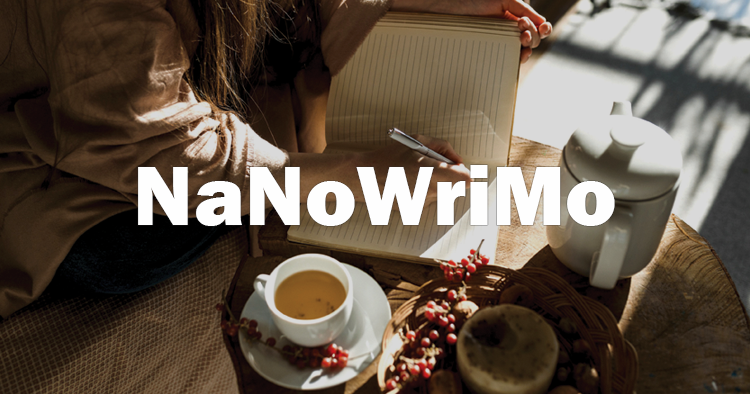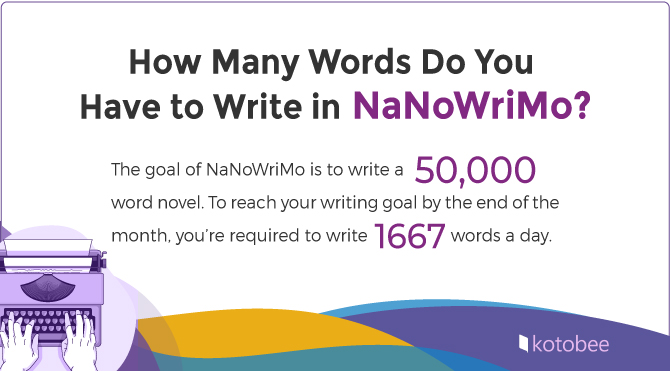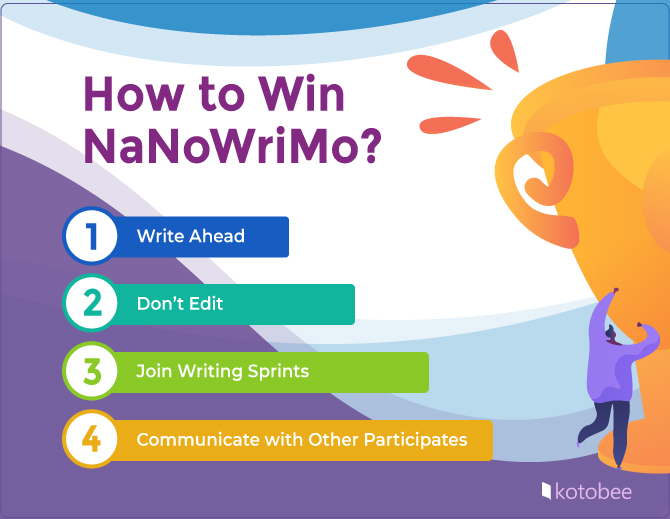Writing a Novel in A Month: NaNoWriMo 2025
It’s almost that time of year again! No, we don’t mean Christmas–though for a writer, it might be the same thing. Perhaps a little more stressful. We’re referring to NaNoWriMo 2025 coming to you this November! The time of year when writers from all around the world gather to write a novel in a month.
This writing challenge has gained global traction for the past decade, with traditional, self-published, and unpublished writers. As they all have book ideas in their heads, this challenge offers them the ideal setting and opportunity to finally get some writing done.

Let’s face it, most of us are full-time employees, students, or simply lead busy lives. Being able to make time for writing can be difficult and induce a lot of guilt over other things that are probably more important for one reason or the other. But that’s what makes NaNoWriMo special.
With a whole dedicated month, you can program your brain to prioritize writing over everything else, all by setting a particular deadline and having other participants from around the globe doing it at the same time. But if you’re new to the scene and don’t really know much about NaNoWriMo, here’s a detailed guide to help you navigate this worldwide phenomenon.
What is NaNoWriMo?
NaNoWriMo stands for National Novel Writing Month. It is a writing challenge that takes place in November of each year, with the aim of writing a 50,000-word novel in any language. There are no rules to the challenge; you simply need to keep a steady word count of around 1667 words each day to reach your writing goal by the end of the month.
The main purpose of NaNoWriMo is to promote creative writing for people from all around the world. Initially, it started with only 21 participants back in 1999; the number has since grown to 427,653 participants in 2021. The challenge starts every year on November 1st and ends on November 30th.
Throughout the years, there have been new allowances to the type of writing you want to get done, and what stage of the writing process you’re in. Whether you’re prepping, on the first draft, the second draft, revising, and so forth.
Since this is a non-profit organization based in the US, NaNoWriMo runs on sponsorship and donations from participants who cherish the experience and want to help other writers like themselves continue to join in and write each year. In turn, signing up for the website and joining the challenge is completely free of charge.

Who Can Participate in NaNoWriMo?
The simple answer is anyone older than 13! As long as you abide by the code of conduct, have something to write, and respect other participants, you’re more than welcome to take part in this challenge.
While it can be daunting to embark on such a big writing journey for the first time, you’ll have a lot of support from other writers and your region’s municipal liaison (defined below). So if you ever feel lost, be sure to reach out to them!
Who is a Municipal Liaison (ML)?
A municipal liaison is a volunteer NaNoWriMo participant determined to support other writers in a particular region. The word “region” here can refer to either a continent, country, state, or even city, depending on the number of participants in the area and the number of volunteers who had signed up.
The ML is in charge of moral support, hosting real-life and online meet-ups, as well as writing events. While it is difficult to find an ML for each region because of the sheer number of regions around the world, participants do appreciate their involvement and everything MLs do for them.
Some regions have so many volunteers that they sometimes end up with Co-MLs. As a bonus point, MLs get an ‘ML kit’ right before the start of NaNoWriMo with free merch! Such as stickers to hand out to participants in the region, a poster to hang wherever they host an event, and a special badge that helps people in the crowd identify them as the person in charge.

What Does the NaNoWriMo Website Offer Participants?
The NaNoWriMo website is well-equipped with various things to help people who are struggling or those who are doing it for the first time. This includes:
Announcing Your Novel
You can’t start writing without an idea in mind. So the first thing you are prompted to do once you sign up for NaNoWriMo is to announce your novel. This will help you feel more committed and focus on the idea you want to see all the way to completion.
Novel Stats
One of the most important pages you’ll find under your ‘My NaNoWriMo’ menu is the ‘Stats’ page. Here’s what will find on this page:
- The total words written
- Words you need to write each day
- Your daily writing streak
- Any progress updates
- A graph/bar chart of your overall progress
- When you tend to write (based on your input)
- A graph/bar chart of your daily word count
- Where you write (based on your input)
- Your average word count per day
- When you’ll finish with your current pace
- Your writing speed (based on your input)
- How you feel as you write this novel (based on your input)
Many participants are dependent on their stats page as it helps give them a lot of insight into their writing goals, their writing speed, and their writing habits. Whether they prefer to write in the morning or if they’re night owls. How much do they usually write per session, and so on and so forth. It can be very interesting, especially when you would like to understand your writing habits and what affects them, or when in the day you do your best writing.
All this information is collected when you update your daily word count whenever you write. Along with the word count, you get some quick questions on when you did your writing, how you felt as you wrote, how long the session had lasted, etc.

NaNo Prep
One of the best ways NaNoWriMo helps its participants is by trying to have them be as prepared as they can be before the month even starts. To do that, the website has a NaNo Prep calendar with activities and checkpoints to help you feel more in control before the month even starts.
Pep Talks
Another way NaNoWriMo helps support writers is by including a host of ‘Pep Talks’, both new and old, on their site. They invite big-name authors to encourage new writers, talk about their own struggles, and show how they overcome them. From N. K. Jemisin to John Green, Brandon Sanderson, Chuck Wendig, Erin Morgenstern, Meg Cabot, Jenny Hann, Victoria Schwab, and even Neil Gaiman.
Region
Finding people who have similar interests in your vicinity can do loads to help you write and meet other writers, whether virtually or in real life! The best thing about joining a region is that you can communicate with those who have a good understanding of what you’re going through and your own experiences with writing, as you both come from similar backgrounds.
Forums
You can join forums within your region or outside of it. There you can discuss all sorts of topics with other participants, as well as do other fun activities, such as ‘adopt a world’ or a character. Basically, when people put a lot of effort into developing a world, but wind up not wanting to write the story anymore, they offer it to other writers.
The forums are very extensive, and you can even start your own! They include everything, from information for newbies to help with story development, novel draft aftercare, finding a crew, writing groups, tips to help you reach 50K words, as well as other helpful resources and topics based on different genres.
Merch
One of the fun ways to show your participation and appreciation of NaNoWriMo is by buying some of the cool merch that comes out every year. While you can buy some stuff from old collections, each year they release new products to fit a new theme. From books to stationery, posters, mugs, and clothing items, you can be all set for NaNoWriMo and get in the spirit of the month.
Now What?
Not only does the challenge try to help authors write as much as they possibly can within the span of a month, but it also likes to guide them on the next steps to take once the challenge is over. That is where the ‘Now What’ stage comes in.
Along with the prizes, there is a calendar of events and steps to take once you’re done with the novel writing month, as well as online events you can participate in or join so your progress doesn’t go to waste.
After all, what is the point of working so hard for an entire month to write a novel, when it is lost among your other works in progress? You need to do something with your novel, and the ‘Now What’ part helps a lot with that.
Software Discounts
Just by signing up for NaNoWriMo, participants get discounts on various writing and publishing software. This includes Scrivener, ProWritingAid, IngramSpark, and many other websites that will help you get your writing done and win this challenge.

How Do You Win NaNoWriMo?
To most NaNoWriMo veterans, getting to 50,000 words is easier than for newbies, but not always guaranteed. The challenge actually comes with its own share of common practices that help writers put a dent in their writing goal and get to the finish line.
1. Write Ahead
The glorious thing about NaNoWriMo is that at the start of the month, you are always full of energy and excitement. Use that momentum as much as you can. Let it drive your word count, and don’t settle for the recommended word count of 1667 words a day. If you reached your writing goal and you’re still excited about your novel and want to keep writing, do it.
Naturally, if you have other obligations in your life, it would be better to prioritize them over your writing. But if you have the time and nothing else you need to do, keep on writing. Trust me! Before you know it, that momentum will be gone.
That way, even if you can’t reach the daily word count for one or two days, you won’t be that far behind, and you’ll find the idea of getting back on track much less daunting.
2. Don’t Edit
One thing we, as writers, might all be guilty of doing is tending to go back and edit our novels as we write. That might be because we either wrote it in a rush, we changed our minds, or for some other reason. I’m here to tell you: don’t. Don’t edit!
The best piece of advice most NaNoWriMo veterans recommend is to shut down or kill your inner editor just for the month. Why? The aim of NaNoWriMo is not to come out at the end of the month with the perfect novel. That’s virtually impossible, so the best thing to do is not to try.
The goal is to write down that story you’ve been wanting to write for months now, and finally commit to it. If you keep going back to edit and fix your mistakes, you’ll lose momentum and interest in your story. Your word count will be affected, you’ll be hindering your own progress, and you’ll eventually stop writing altogether.
Is it possible if you don’t go back to edit you’ll end up hating everything you’ve written and throw it all away? Yes, and that’s okay. The main point is that you wrote something! You committed to writing a novel; you sat down and made it happen. Now you have a clearer picture of what you hated or absolutely loved about your book. It’s not just about the book you’re writing, it’s a whole learning experience.
3. Join Writing Sprints
Something almost every NaNoWriMo participant swears by is writing sprints. They are a huge part of the challenge’s culture. Writing sprints are basically when you are given an allotted amount of time to write and challenge your friends to see how many words you can write within that time frame.
Writing sprints can last from ten minutes to one hour, depending on your preference. NaNoWriMo even has a NaNoWordSprints account on Twitter for official word sprints.
4. Communicate with Buddies and Other Participants
The best part about NaNoWriMo is the sense of community! With everyone struggling to reach 50,000 words, there’s a great element of camaraderie that comes with it. You get to meet new people through your region, the NaNoWriMo Twitter account, using the hashtag #NaNoWriMo, or by adding buddies from other platforms.
Whenever you’re behind or struggling, you are guaranteed to find someone who won’t only commiserate with you, but even if they’re suffering just as much, they will do everything in their power to lift you up. As much as writing is, in itself, a solitary experience, being surrounded by fellow writers can be a huge boost to your willingness to keep going.

What Do You Win When You Reach 50K?
If you think to yourself that you already know the best things about this writing challenge by now, you’re wrong. The best thing is, after this program helps you reach your writing, they hand out prizes!
Yes, you get a reward for finally writing that novel you’ve been talking about writing for, Lord knows how long. And not just a certificate, which you do get as well. One of the best long-standing gifts is a 50% discount on the writing app Scrivener for winners. And the list is long, including mentorships, writing competitions, and editors, among other things.
What Popular Novels Were Written During NaNoWriMo?
Many people aren’t aware of this, but some of our favorite books have started out as NaNoWriMo projects! Some authors aren’t just one- or two-time participants, but rather regulars with this challenge.
Take for example Susan Dennard. Not only was her book Something Strange and Deadly written during NaNoWriMo, but it was also published in 2012. However, that wasn’t all! Susan Dennard has spent a lot of the following years not only participating in NaNoWriMo but also joining forums to help other writers. She even regularly hosted writing sprints on Twitter.
The same goes for Marissa Meyer, whose books Cinder, Scarlet, and Cress were all written during NaNoWriMo. Meyer would even create fun challenges throughout the month for fellow participants to keep things interesting.
The interesting thing about NaNoWriMo is that many authors view the experience in a myriad of different ways. Alexandra Bracken, for example, credits the writing challenge for helping her ‘catch the writing bug’. On the other hand, Sarah J. Maas admitted that while she loved NaNoWriMo, writing a draft for a novel in such a high-stakes manner wasn’t really for her, yet she still cherished the experience.
That still doesn’t negate the fact that many authors find the experience exceptionally fulfilling and beneficial to their writing process. Here are a few out of hundreds of books that were published during the writing month!
- The Darwin Elevator by Jason Hough
- Wool by Hugh Howey
- Fangirl by Rainbow Rowell
- Don’t Let Me Go by J.H. Trimble
- The Night Circus by Erin Morgenstern
- The Art of Crash Landing by Melissa DeCarlo
- Water for Elephants by Sara Gruen
- Anna and the French Kiss by Stephanie Perkins
(As well as both Lola and the Boy Next Door and Isla and the Happily Ever After) - An Absolutely Remarkable Thing by Hank Green
- Persistence of Memory by Amelia Atwater-Rhodes
- With the Fire on High by Elizabeth Acevedo
- Take the Reins by Jessica Burkhart
- The Boy Who Steals Houses by C. G. Drews
- The God Patent by Ransom Stephens
- Olivia Bean, Trivia Queen by Donna Gephart
- Bloodwitch by Amelia Atwater-Rhodes
(As well as both Token of Darkness and Mancer) - The Beautiful Land by Alan Averill
- The Forest of Hands and Teeth by Carrie Ryan
- The Hungry Season by T. Greenwood

What to Do Once You’re Done with Your Novel?
While completing the novel itself might take far longer than the duration of NaNoWriMo, it is important to start thinking about the next steps. Will you be sitting on this novel? Do you intend to self-publish or go the traditional route? Maybe you prefer going with a hybrid publisher or an aggregator?
Whatever you choose to do next, you should first contemplate how you’re going to export your novel, depending on the required format for the aforementioned options. And if you want the best way to format and showcase your novel, you might want to give Kotobee Author a try.
With Kotobee Author, you have a variety of options in designing and structuring your novel, as well as how or where you can showcase it. You can export it in any format you like, from basic formats such as epub3, Mobi, and PDF, to web and mobile apps. You can even publish it straight to Kotobee Books for free and get 100% royalties from any sales you make!
Other Writing Programs Associated with NaNoWriMo
Young Writers Program (YWP)
As the goal of NaNoWriMo is to promote both writing and inclusivity, it does its best to offer opportunities to writers of all ages, including young and budding writers. YWP is a program for those under 18 who wish to join the challenge, and K-12 educators to help their students get involved with writing challenges throughout the year.
Camp NaNoWriMo
If you’re a fan of NaNoWriMo and think it’s a shame that it happens only once a year, don’t worry! NaNoWriMo runs 2 camps in April and July to help give writers more time to focus on writing. The rules during these camps, however, are a bit different and a little less strict as you get to choose your word count.
The downside is that not many people participate in the camps as they do in the more popular writing challenge. This means you will lose the most vital aspect of NaNoWriMo: the community. Also, not the same prizes are offered.
Conclusion
For many writers, NaNoWriMo is a sacred time of year that helps cultivate a supportive connection with other writers. It also gets people writing and giving their work some serious thought. Writing a novel in a month is by no means an easy task, but it’s definitely worth the experience. So, are you ready to win NaNoWriMo 2025?

















Mahmoud Mohamed
October 23, 2022Nice article! thank you for the valuable info.
SavePlus
August 2, 2025Great breakdown of NaNoWriMo! Loved how you highlighted its impact on writers’ creativity and discipline.